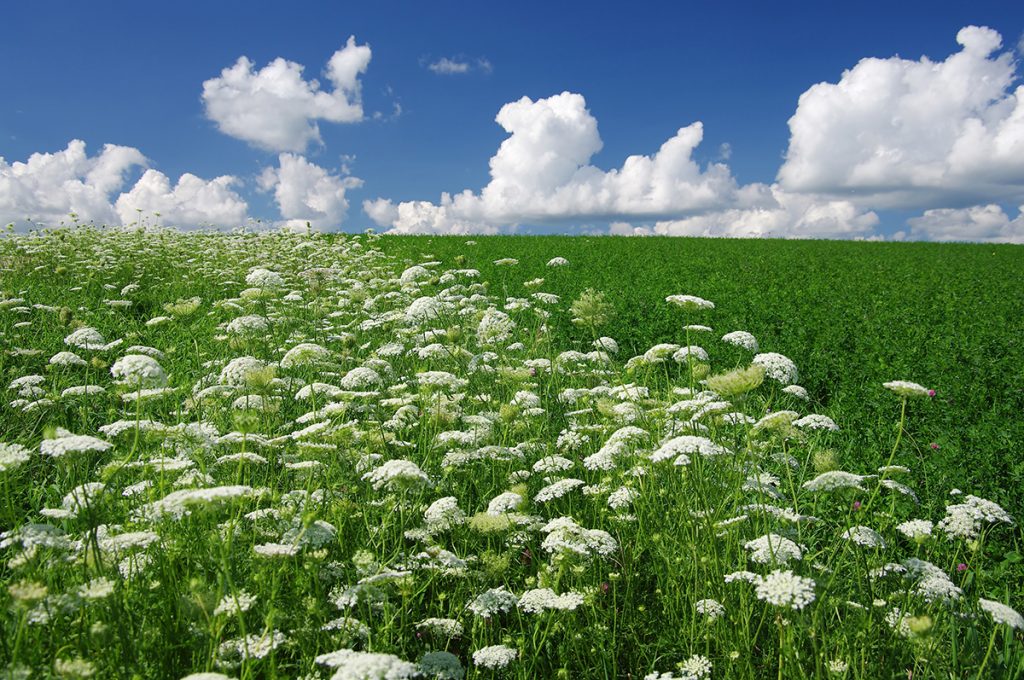
Looking for a unique and delicious way to enjoy the beauty of Queen Ann’s Lace? Look no further than Queen Ann’s Lace Jelly! This whimsical and flavorful jelly is made from the delicate flowers of the Queen Ann’s Lace plant, which is found growing wild in many parts of the world. In this article, we’ll explore the history of this charming flower, share tips for identifying it in the wild, and provide step-by-step instructions for making your own batch of Queen Ann’s Lace Jelly. So grab a cup of tea and settle in – it’s time to explore the world of Queen Ann’s Lace!
What Is Queen Ann’s Lace?
Queen Anne’s Lace (Daucus carota) is a plant commonly found in North America, Europe, and Asia. It is also known as Wild Carrot, Bird’s Nest, and Bishop’s Lace. Queen Anne’s Lace is a biennial plant, which means it completes its life cycle over two growing seasons. In its first year, it produces a rosette of leaves close to the ground, while in its second year, it sends up a flowering stem that can reach up to 3 feet tall.
Queen Anne’s Lace is a member of the carrot family and closely resembles the domesticated carrot, with its feathery foliage and umbels of small, white flowers. The root of Queen Anne’s Lace is edible and has been used for centuries as a food source and as a medicinal herb.
One of the most notable uses of Queen Anne’s Lace is its ability to stimulate menstruation, hence its nickname “Wild Carrot.” It has also been used to treat urinary tract infections, coughs, and bronchitis. Queen Anne’s Lace contains vitamins and minerals, including vitamin A, vitamin C, and potassium, making it a nutritious addition to a healthy diet.
In addition to its medicinal uses, Queen Anne’s Lace is also a popular wild edible. The roots, leaves, and seeds are all edible and can be used in a variety of dishes. The root can be roasted and used as a coffee substitute, while the leaves can be used in salads or cooked like spinach. The seeds can be used as a spice or seasoning, and have a flavor similar to that of dill.
However, it is important to note that Queen Anne’s Lace can be confused with other plants, such as poison hemlock, which is highly toxic and can be deadly if ingested. Therefore, it is essential to properly identify the plant before consuming any part of it.
Many places in the Ozarks see these plants explode with white, lacy flowers during the early summer. They continue to bloom into late summer. The young taproots are edible, and they smell just like domesticated carrots. As the roots get older they become woody, making them not as palatable. The flowers can also be fried, and in some areas, fried Queen Ann’s Lace flowers are considered a delicacy.
How Did It Get Its Name
Its name has an interesting history that adds to the intrigue of this versatile plant.
Legend has it that Queen Anne’s Lace was named after Queen Anne of Great Britain, who ruled from 1702 to 1714. According to the legend, the queen was an expert lacemaker and often used a spindle to make her intricate designs. One day while she was making lace, she pricked her finger with the spindle and a drop of blood fell onto the lace. The resulting pattern is said to have resembled the delicate and intricate flower head of Queen Anne’s Lace.
Another legend states that the plant was named after Queen Anne of Denmark, who was the wife of King James I of England. She is said to have introduced the plant to England, where it quickly became a popular garden flower. The name Queen Anne’s Lace may have been given to the plant in honor of the queen.
Despite its delicate and lacy appearance, Queen Anne’s Lace is a hardy and resilient plant that has many uses.
Scientists still debate the purpose of the single dark flower in the middle of the cluster of white flowers that adorn the tops of these plants. Some say its purpose is to mimic an insect already on the plant. Other studies have shown no effect of this single dark flower on the behavior of pollinating insects. Either way, this is one of the things to look for to identify the plant.
Use Extreme Caution
I cannot stress this enough if you decide you want to make this jelly you must be absolutely sure you can identify this plant. Poison hemlock looks very similar! Yes, the poison hemlock that Socrates was forced to drink in ancient times.
The flowers of Queen Ann’s Lace grow in a cluster and poison hemlock is a loose collection of individual flowering tops. The stem of Queen Ann’s Lace is hairy, while those of poison hemlock and water hemlock are smooth. Poison hemlock also usually has purple blotches on the stem that are not found on Queen Ann’s Lace. But again, this is not something to take lightly. Poison hemlock and water hemlock are extremely toxic. People have made the mistake in identification and have died as a result.
I want to stress that this post is not a guide to identification. If you aren’t sure about your identification you should avoid this plant. I cannot stress this strongly enough.
My First Attempt At Making Queen Ann’s Lace Jelly
Now that we have the cautionary statements out of the way, let’s see how my first attempt at making this jelly turned out.
Gather Supplies
The first step was to gather my supplies. I needed the following:
- A dozen half-pint canning jars with lids
- 2 boxes of powdered pectin
- 7 cups of sugar
- Lemon juice
- A large pot
- A medium saucepan
I gathered all my supplies, and then it was time for me to start making jelly.
Harvesting Queen Ann’s Lace
The next step in the process was to find a large stand of Queen Ann’s Lace so that I could get about 30 large flowering tops. Always harvest responsibly and never take more wild plants than you need. Leaving a large percentage of plants in the area you harvest from assures that you will have a supply in the future. Respecting the bounty of wild plants Mother Earth supplies for us assures us that future generations will be able to find and use the bounty of amazing plants for food and herbal medicine.
Prep Work
Once I had gathered my flowers it was time to rinse them and place them on a towel to drain and give time for any lingering insects to vacate the flowers before starting to make jelly.
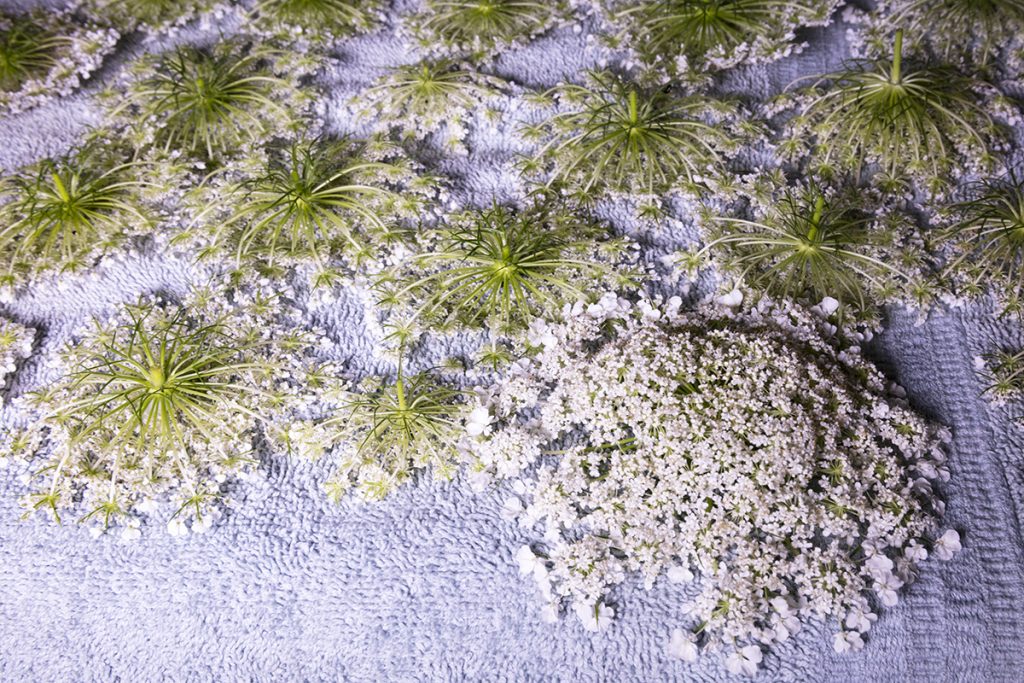
While the flowers were drying I sanitized my jars. To do this I placed the jars in a large pot and completely covered them with water. I brought the water to a boil and let the jars remain in the boiling water for 5 minutes then turned off the heat. You could also run your jars through the dishwasher to sanitize them.
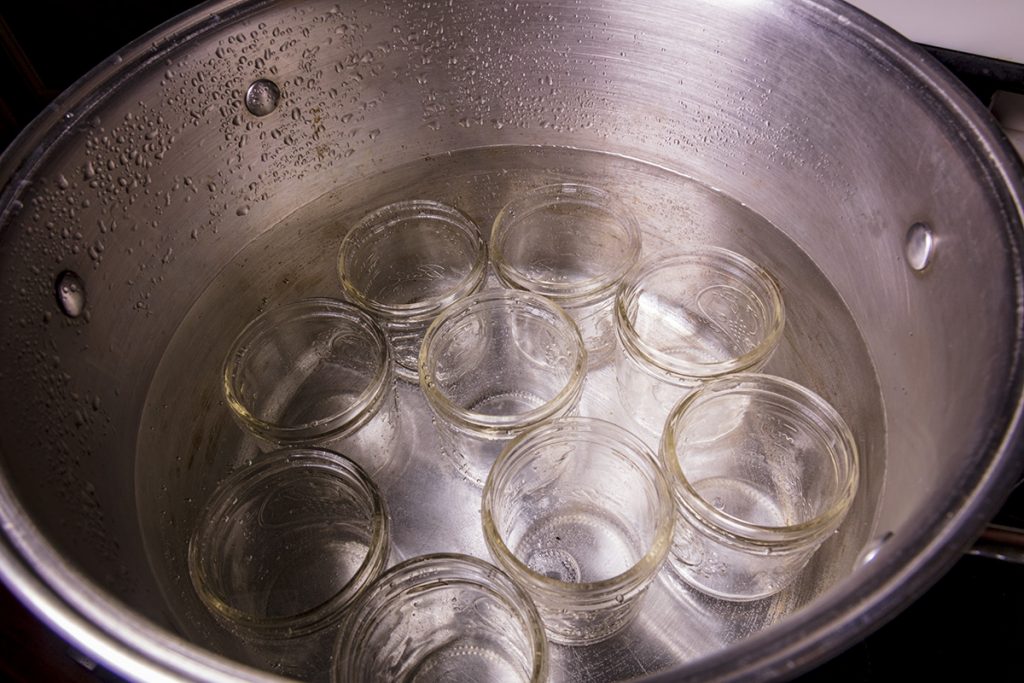
Making Queen Ann’s Lace Jelly
Once this was done it was time to start the process of making the jelly. I placed 7 cups of water in a large saucepan and brought it to a rolling boil. Once the water was boiling I removed it from the heat and placed the flowers in the water to steep. I covered this and let it steep for 15 minutes.
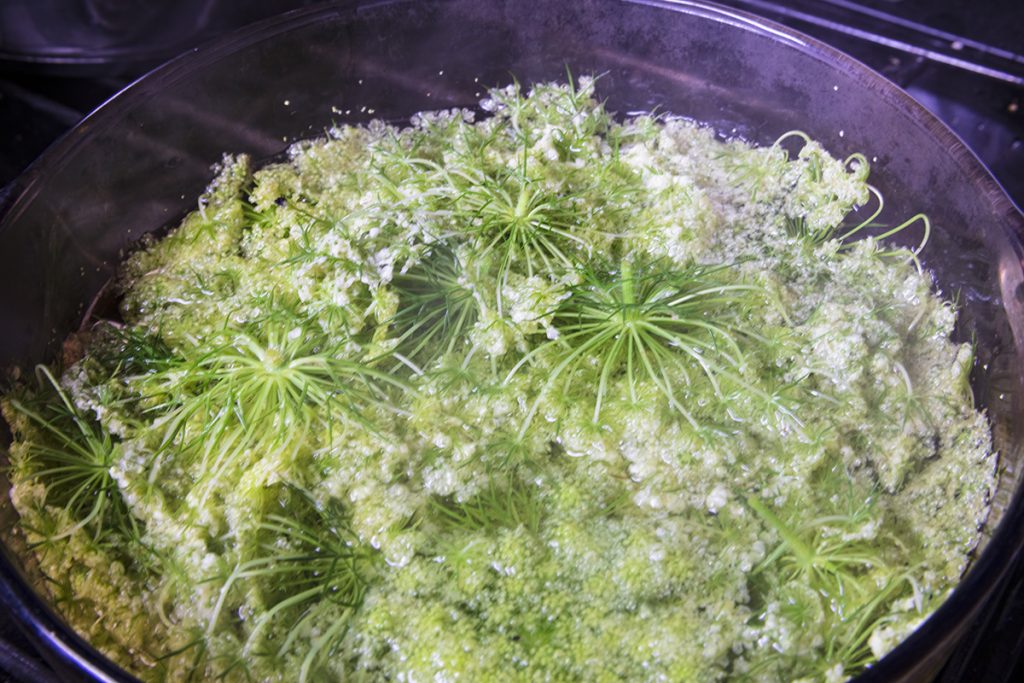
Once the flowers finished steeping I strained the liquid through a fine-mesh coffee filter to remove any solid material from the liquid. I then rinsed the pan and returned 6 cups of the liquid to the saucepan. You’ll notice the liquid has now taken on a beautiful golden color.

I turned the heat back on and stirred in 2 boxes of powdered pectin. After the mixture returned to a boil I stirred in 7 cups of sugar all at one time and 3 tablespoons of lemon juice. I used a whisk while stirring to make sure everything dissolved properly. Then I continued to stir as the mixture came back to a rolling boil.
Once boiling I set the timer on my phone for 1 minute. When the timer went off I tested it, and it wasn’t quite to the gelled stage. I gave it about another 20 seconds, and it was gelling. I then removed the mixture from the heat and started skimming the white scum that forms on top. I used a spoon to remove this scum by gently skimming the spoon across the top of the mixture until all the white scum was removed.

Now I was ready to add my jelly to my jars. This recipe says it makes about 10 half-pint jars and that is exactly what I came out with. I knew it would be impossible to pour directly from the saucepan into half-pint jars without making a huge mess. Instead, I used a 1 cup measuring cup to dip out the jelly and carefully pour it into the jars. I made sure to leave about 1/4″ of headspace in the jar and then put the lids and bands on finger tight. This recipe has enough acidity due to the lemon juice that I could use the water bath method of canning. I found these rules for safe water bath canning.
I then placed my jars back in the large pot I used for sanitizing the jars. I made sure the water covered the entire jar by at least 1 inch or more. I brought the water back to a rolling boil and set the timer for 10 minutes. After the timer went off I removed the jars using a set of kitchen tongs. There are also special jar tools for this you can purchase if you prefer.
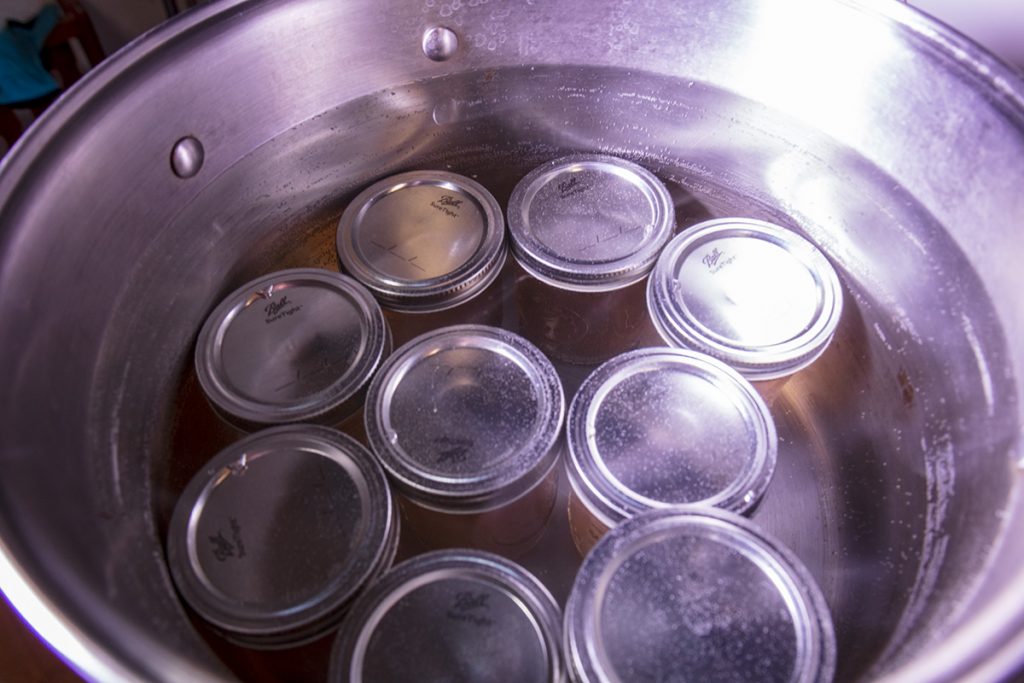
I made sure I had laid a towel down for the jars to sit on as they cooled. This prevents breakage from temperature shock, which can happen when setting the hot jars on a cold counter. Then I simply went about my business until I heard the first lid pop as it sealed. The rest started popping in pretty rapid succession.
I had 2 jars that the indicator in the lid didn’t pop. Those I placed in the refrigerator after they cooled overnight. Those will be eaten first. I placed the rest in the cupboard, so I will have this absolutely delicious jelly for a while.
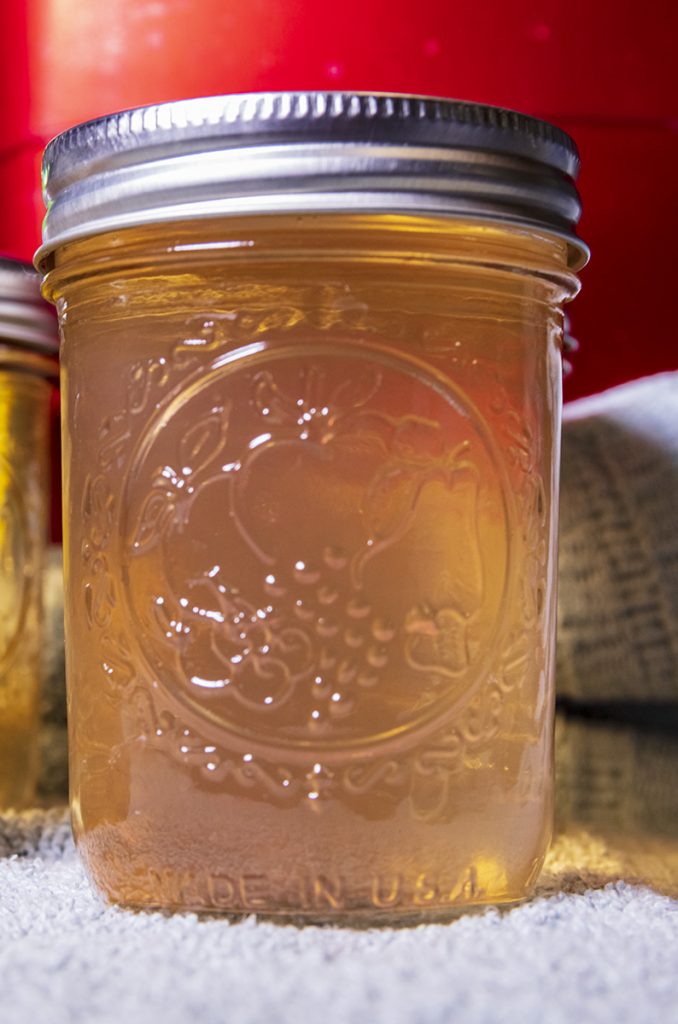
Results
I must admit I was surprised at how good this jelly turned out on the first attempt. It tastes to me somewhat like honey with lemon. I’m sure I’ll be making more now that my experiment turned out better than I had hoped!
One last time I want to caution you that if you cannot positively identify this plant, do not try this without consulting someone who can help you positively identify it. The plants that look similar are extremely toxic and may cause poisoning and death. Don’t take a chance, know your plants!
For more information about other wild medicinal plants and essential oils, you can visit our list of articles.
Disclaimer: This article should not be construed as medical advice. The health information in this article is not intended to assess, diagnose, prescribe, or promise a cure for any medical condition. Consult with your health care professional before considering any natural supplement or plant remedy for your health and wellness. We assume no liability for the use or misuse of the material presented above. Always consult with a medical professional before changing your diet, or using manufactured or natural medications.
We also handcraft a unique Queen Ann’s Lace syrup.
FAQs:
Q: Is any part of Queen Anne’s lace edible?
A: Yes, the young shoots, leaves, flowers, and roots of Queen Anne’s lace are edible.
Q: What is the difference between wild carrot and Queen Anne’s lace?
A: Wild carrot and Queen Anne’s lace are the same plant. Wild carrot is the plant’s common name, while Queen Anne’s lace is its more popular name.
Q: Where does Queen Anne’s lace grow in the US?
A: Queen Anne’s lace grows throughout the United States and is particularly common in fields, meadows, and along roadsides.
Q: Why is Queen Anne’s lace called that?
A: Queen Anne’s lace is named after Queen Anne of Great Britain, who was a lacemaker and loved the flower’s lacy, white blooms.
Q: What does Queen Anne’s lace taste like?
A: The taste of Queen Anne’s lace is often described as earthy, sweet, and slightly carroty.
Q: Are there toxic look-alikes for Queen Anne’s lace?
A: Yes, there are several plants that resemble Queen Anne’s lace and are toxic, such as poison hemlock and water hemlock. It is important to properly identify Queen Anne’s lace before consuming any part of the plant.
Q: What colors does Queen Anne’s lace come in?
A: Queen Anne’s lace typically has white or cream-colored flowers.
Q: Can Queen Anne’s lace be purple?
A: No, Queen Anne’s lace does not come in purple. However, there are other plants that are commonly called “wild carrots” that can have purple flowers.
Q: What does the color of Queen Anne’s lace mean?
A: The color of Queen Anne’s lace flowers is typically white or cream-colored and does not hold any particular symbolic meaning.
Q: Are there different types of Queen Anne’s lace?
A: There is only one species of Queen Anne’s lace, but there are several varieties and cultivars that have slightly different characteristics.
Q: What does Queen Ann’s Lace Jelly taste like?
A: Queen Ann’s Lace Jelly has a sweet, floral taste with a hint of citrus and is often compared to honey.